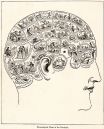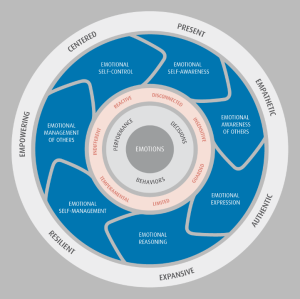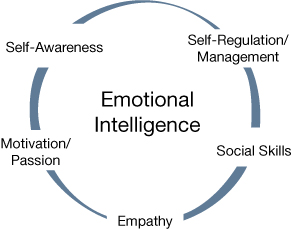Is time management an outdated concept?
Linda Ray, the co-founder and co-director of neuresource group, coined the term “attentional intelligence” in 2012. In this post, she looks at how when we speak about ‘time management, what we are really talking about is ‘attention management’.
_________________________
There are a plethora of time management training programs that employees have been obliged to attend in an attempt to support them to become more efficient and ultimately more productive. The question is: do they work?
There is no doubt people walk away with a few useful tips, but do these training programs actually change employee habits around how they manage their time? From my observations and personal experience, the answer is often a resounding no. Is it, in fact, time we are managing? Or are we really managing our attention and focus in an attempt to be more productive?
The issue is really how in charge of our focus and attention we are in the increasingly hyperkinetic world we find ourselves operating within. In a recent interview, Daniel Goleman, the author of Focus: The Hidden Driver of Excellence, notes:
It has become an axiom of modern life that we’re a people under attack, assailed by a barrage of technologies and near-constant communications. Amidst this wealth of data and information, one resource is in short supply: our ability to pay attention.
As we learn more about human behaviour through our increasing understanding of the brain, we need to be ready to rethink some of our approaches to how we approach time management. How can we get back in charge of our attention and ultimately reclaim our time — or lack thereof?
In an article published in Global Association for Neurobiology Studies in 2009, by Lynda Klau she suggests that old solutions to time management don’t work and most traditional approaches to time management only ask us to change our behaviours, as if all our conflicts with time could be solved simply by ‘establishing our priorities’, ‘sticking to a concrete schedule’, or ‘organising our files’.
These external solutions are logical, but they’re not psychological: they ignore the internal emotional conflicts and pressures that influence us on the most fundamental levels. Klau proposes that key to improving our relationship with time is to develop a ‘mindful awareness’ of ourselves at all levels.
Students in our Diploma of Neuroscience of Leadership report noticeable improvements in their productivity through being introduced to simple concepts that support them to grow their ‘attentional intelligence’. For example:
It seems so obvious, and yet we don’t do the things each day that support us to be productive. I have been amazed at the improvements in my productivity by simply prioritising prioristing, practicing mindfulness and taking charge again of my attention. I now know how mentally taxing prioristising is and why I need to do it at the beginning of my day if I am to have any hope of getting through my ever expanding to do list. There is intense satisfaction in crossing off a greater number of items each day because I am now much more mindful of where my attention is focused and whether it is where it should be or I want it to be.
.
Replace time management strategy with a focus management strategy
Given the importance of attention and focus we recommend you develop a focus management strategy. Try out the following tips:
- Do a distraction management audit. Identify all of the external and internal distractions that vie for your attention and develop strategies to minimize them (e.g., turn off the pop-up email alert and ensure you don’t start a hard thinking task when you are hungry or thirsty).
- Chunk your day into the areas you want to focus on that will add value and schedule them into your diary. If you notice your attention moving from your plan, gently bring your attention back to where you want it to be.
- Try to remain in the present moment, if you notice your thoughts turning to past events or to the future, bring your attention back to the present moment.
- When you run out of puff, rather than pushing yourself to the limit, take a brain break. This might sound counter intuitive, however, we know the brain works best in 20-25 minute time periods before we begin looking for a different focus for our attention. Work with your natural biology as opposed to against it.
- When you experience something unexpected that leads to frustration, anger, or disappointment, notice the feeling and label it. The very act of labelling your feeling or emotion will lessen the impact and dampen down arousal in your limbic brain. The limbic brain is designed to make us pay attention to perceived threats in the environment and can easily derail our best intentions to stay focused.
- Celebrate what you have achieved in the day rather than ruminate on what you haven’t accomplished, and reset your attention plan for the next day accordingly.
Developing your attentional intelligence and becoming the CEO of your attention is key to reclaiming time. Implementing simple strategies to notice where your attention is focused and to bring it back to where you want it to be will improve your productivity and maybe even give you some extra time to do the things you enjoy.
_________________________
 Linda is the Managing Director of NeuroCapability and the co-founder/director of neuresource group. These organisations are playing key roles in developing a new generation of thinking leaders through delivery of the Diploma of Neuroscience of Leadership and other innovative programs informed by neuroscience. Linda is gaining recognition both in Australia and internationally as a thought leader in the neuroleadership field. She is actively contributing to the body of knowledge that supports the building of individual and organisational ‘neurocapability’.
Linda is the Managing Director of NeuroCapability and the co-founder/director of neuresource group. These organisations are playing key roles in developing a new generation of thinking leaders through delivery of the Diploma of Neuroscience of Leadership and other innovative programs informed by neuroscience. Linda is gaining recognition both in Australia and internationally as a thought leader in the neuroleadership field. She is actively contributing to the body of knowledge that supports the building of individual and organisational ‘neurocapability’.
.
.
Six brain-based ideas for better innovation
Adair Jones, a Brainwaves for Leaders staff writer, has been thinking a lot about the neuroscience of innovation. She includes a round up of some of the latest thinking on the subject.
_____________________________________________
Survival Mind v Innovation Mind
There are two main areas where biology affects innovation. First, the human brain is built to resist change. In order to conserve the status quo, the brain generates feelings of discomfort when we try new things or attempt to change. This is counterbalanced by other systems, driven by dopamine, that reward exploration and discovery. As humans in business, when our ‘survival mind’ is activated we instinctually focus on keeping ourselves in the safe zone. When our senses are heightened by a threat, we are driven by our unconscious minds to hunker down in the status quo in order to prepare for the next threat. We freeze in place, something that is not conducive to innovation.
According to Janet Crawford, a pioneer in applying neuroscience to improve business performance, we are pattern-making creatures.
From the time we’re born, our brains are busily encoding any useful and repeating relationship between objects and events to which we’re exposed. Since the brain possesses very little capacity for conscious attention, it uses these patterns to automate our responses to the environment as much as possible.
It’s our conscious mind that creates new ideas and focuses on the future, but when we’re in our ‘survival mind’, our unconscious is in charge.
It’s a balancing act, however. When we experience too much stress and threat, the tendency is to retreat into habitual known responses. When we feel sufficiently (but not overly) secure, we venture into new territory. The prefrontal cortex, the area resting just behind your forehead, is key to innovative thought.
Only by leading our teams out of ‘survival mind’ and into their ‘innovation minds’ can new ideas emerge. By creating an environment that reduces threats while fueling creativity, we can quiet the unconscious mind and empower the conscious mind to innovate – again and again and again.
How to Foster Innovation Mind
1 Take care of your brain
Crawford argues that the areas of the brain involved in innovation are particularly sensitive to sleep deprivation, poor diet, lack of social connection, and stress in general. Fatigue management expert Thea O’Connor weighs in on the benefits of working in tune with our rhythms rather than fighting against them, not only to feel more energised and less fatigued, but to open the pathways of creativity and innovation.
2 Step Into Your Innovation Mind
By understanding how to calm our unconscious minds and simultaneously fuel our conscious innovation – we can power creativity within our teams. For example, simply modelling the innovative behaviour of others can help bring about a mind shift.
Address the brain’s need for certainty by pointing out the challenges, the risks, the downside potentials of remaining in that very status quo. Then visibly reward those who step into new thinking. The combination will motivate teams toward new and conscious solutions. Ask a lot of questions: By questioning the knowns of the business, eliminating sacred cows, and probing into the new and innovative, you can inspire a out-of-the-box thinking.
3 Expose yourself
Think fresh by exposing yourself to new and different ideas, disciplines, cultures, and environments. There’s a tendency in business to hunker down, focus, and try to get as much done as possible in as short a time as we can. If we can’t think of a compelling reason for something to happen, we consider it a luxury or waste of time. Great innovations happen when there’s a large pool of seemingly unrelated content to pull from. Set time aside to cross pollinate even if the immediate benefits aren’t obvious. As Crawford says: “The more diversity in the system, the more “weeds” will flourish and the greater the likelihood that some of them will be useful!”
4 Invite others
People within a system often think and see in much the same way. But when you invite others to participate, anything can happen. People outside the system bring fresh neural patterns. Unless there are practices that allow diverse elements in your ecosystem to intersect, and unless you’ve created the safety to prompt people to speak up, vast amounts of insight will remain undiscovered.
5 Develop your attentional intelligence
Linda Ray, a pioneer in building intelligent enterprises, coined the term ‘attentional intelligence’. According to Ray, by mindfully noticing where your attention is at any moment and to intentionally choose where you want it to be, you are setting up the scaffolding in your brain to allow innovation to occur. Daniel Goleman’s extensive research supports this: use your conscious mind to gather data, make connections, and focus. Then, let the brain idle. It’s in the downtime after thorough preparation that innovations happen. In this way you can draw on the extensive array of patterns the unconscious mind has formed, without being in it’s thrall.
6 Play!
It’s in play that we often gain access to our vast unconscious warehouse of neural information. Allow relaxed time for serendipity.
_____________________________________________

. .
Adair Jones is a writing and communications expert with over 20 years experience. She contributes regularly to newspapers, magazines and online journals and has won awards for her fiction. Writing about developments in neuroscience is her latest adventure.
.
.
Read Full Post | Make a Comment ( 2 so far )Want To Advance Your Career? Then Work On Your EQ
Following on from last week’s post by Nick Mills linking emotional intelligence and neuroscience, we couldn’t resist re-blogging this article by Drake Baer for Fast Company on the role of emotional intelligence in job satisfaction and growth.
___________________________________________
In case you don’t yet feel it, emotional intelligence—the ability regulate emotions in one’s self and identify emotions in others—is a predictor of workplace success, both for employees and managers.
Over at Black Enterprise, Amanda A. Ebokosia notes that high emotional intelligence—a topic we’ve been on for 13 years—leads to higher job satisfaction, better decision-making, and more ready goal-completion for employees, while managers lacking emotional intelligence have difficulty with social interactions and nurturing professional relationships.
“Emotions do matter,” Ebokosia writes, citing a pair of studies. “Dismissing them entirely can be detrimental to the workplace, hindering healthy interpersonal interactions and their positive outcomes.”
Emotional rescue
The first study, a meta-analysis, combines a range of research. In aggregate, emotional intelligence is linked with job performance, since “in almost all work settings, individuals have to cooperate with others and do at least some group work tasks,” so emotional intelligence, with its 360-understandingness, gives you a sense of what a social situation needs–and how to correspondingly act.
The second study, the adorably named “Feeling the Future: The Emotional Oracle Effect,” gets into gut feelings. In language familiar to Malcolm Gladwell fans, io9 recaps a gut feeling as “an intuitive summary of all our accumulated knowledge on a topic,” one that is “apparently better than what we could come up with if we tried to consciously synthesize this information.” But note: Your gut is an oracle only if you have prior understanding of the given domain.
Taken together, emotional intelligence—and its associated intuitions—may be helpful for leaders, teams, and companies looking to grow (and create). Drawing from Daniel Goleman’s landmark Emotional Intelligence, Ebokosia describes its five factors of Emotional Intellgience as such:
- Empathy: The ability to shift perspectives and gain a better understanding of others, or, in fancy-pants language, “inter-subjectivize.”
- Motivation: The driving force(s) of your actions. Your compass, north star, wayfinding. Your interior cartographic prowess.
- Self-regulation: Being able to deal with your own emotions before they deal with you. Linked with delaying gratification and not eating the marshmallow.
- Social skills: Knowing what to say in order to engage your team—and knowing how not to offend them.
- Self awareness: Understanding your own emotions improves your interactions, since getting intimate with your feelings lets you better understand how they affect others.
So how to limber up your emotional intelligence? A little foible-self-transparency might be a first step.
___________________________________________
This article first appeared on 28 February 2013 for Fast Company.
___________________________________________
.
Once a backpacker, now a journalist. Longs for Kyoto, lives in Brooklyn, writes about business for Fast Company and other stuff for other places. Drake Baer+
Read Full Post | Make a Comment ( None so far )Linking Emotional Intelligence to Neuroscience
Nick Mills, a Neuroscience of Leadership graduate and the Principal Consultant at Eureka Training, shares his thoughts on emotional intelligence and what learning about the brain can do to help you link the heart with the head.
___________________________________________
“I don’t go in for any of that fluffy stuff at work. Feelings should be kept at home and kept out of work,” declared Steven, the head of Information Technology in Projects at a large well-known software organisation.
This was the first thing to come out of Steven’s mouth as Neil sat down to conduct a pre-arranged 360 degree Emotional Intelligence coaching session with him, arranged by Steven’s Manager. Steven had made both his intentions clear and his feelings known about Emotional Intelligence.
 The irony was not lost on Neil, at least he had something to work with. Steven, a self-professed ‘facts, figures and stats’ kind of guy, was only interested in concrete concepts and ideas proven that have a dependency of outcome. Unfortunately for Steven, and anyone else involved with human beings, the outcome you’d like isn’t always what you get when you deal with people on a day-to-day basis.
The irony was not lost on Neil, at least he had something to work with. Steven, a self-professed ‘facts, figures and stats’ kind of guy, was only interested in concrete concepts and ideas proven that have a dependency of outcome. Unfortunately for Steven, and anyone else involved with human beings, the outcome you’d like isn’t always what you get when you deal with people on a day-to-day basis.
In its purest form, Emotional Intelligence as a concept has been around for thousands of years. Plato articulated concepts such as these in his writings. More recently, Howard Gardner mentioned it in 1983 when he first conceptualised ‘multiple intelligences’. The concept was further popularised in the early 1990s by John Mayer and Peter Salovey , who later went on to form the MSCEIT Emotional intelligence test. Daniel Goleman’s 1995 seminal book Emotional Intelligence: Why it matters more than IQ really put EI on the map and into our consciousness, so to speak.
Steven was about to sit down to have his one on one debrief of the Genos Emotional Intelligence 360 degree report. Understandably, his nerves were on high alert as his brain grappled with the concept of the large threat looming in the debrief of this report. Steven had been receiving several complaints per month from his staff and peers. Complaints ranged from bullying to aggression, to overly unrealistic demands and rudeness, among others things. Little wonder that Steven was feeling more than threatened by the concept of this coaching session.
Neil understood that Steven’s stance masked a deeper inner concern: What would his staff , his peers, and his manager say about him, and what would the impact be? Were they engaged or were they disengaged? Suddenly, it mattered.
There is a wealth of literature linking high employee engagement and positive emotions among employees defining high performance workplaces. Steven was about to find out a little more about his team.
This is a common conundrum facing any coach, HR Manager, Manager, Team Leader, or Supervisor who has ever had to sit down and ‘coach’ someone through the impact of a 360 degree (mostly anonymous) feedback survey. Naturally, the brain heads toward an automatic threat response in this kind of situation. Having some understanding of neuroscience, as well as emotional intelligence, helped Neil.
 Neil chose the Genos model of EI, a popular Australian based EI tool because it comes with a raft of research and a wealth of helpful tools. The Genos model focuses on seven key ‘skill areas’ of emotional intelligence, as it looks upon emotional intelligence as a ‘learnable’ skill, rather than a fixed narrative. This is useful in several ways, particularly for those that eschew populist ‘consultant speak’ or ‘psycho-babble’. It’s based on science and some pretty solid research. Being able to back it further with some simple, irrefutable brain-based facts can be even more helpful for the coach or the manager. For example, our brains core motivation underlying all behaviour and brain processing is to minimize threat and maximize reward. This motivation helps us to decide what is significant at any point in time and the brain is more highly tuned to detecting threat than reward. Given the natural tendency toward actively minimizing threat, Steven’s position was understandable, from both a neuroscience and an emotional intelligence perspective.
Neil chose the Genos model of EI, a popular Australian based EI tool because it comes with a raft of research and a wealth of helpful tools. The Genos model focuses on seven key ‘skill areas’ of emotional intelligence, as it looks upon emotional intelligence as a ‘learnable’ skill, rather than a fixed narrative. This is useful in several ways, particularly for those that eschew populist ‘consultant speak’ or ‘psycho-babble’. It’s based on science and some pretty solid research. Being able to back it further with some simple, irrefutable brain-based facts can be even more helpful for the coach or the manager. For example, our brains core motivation underlying all behaviour and brain processing is to minimize threat and maximize reward. This motivation helps us to decide what is significant at any point in time and the brain is more highly tuned to detecting threat than reward. Given the natural tendency toward actively minimizing threat, Steven’s position was understandable, from both a neuroscience and an emotional intelligence perspective.
Emotional Self Awareness and the Neuroscience of Mood
Emotional Self Awareness is the skill of perceiving and understanding one’s own emotions. Knowing that stimuli that comes into our brain first is processed unconsciously and can activate one of six key emotions. This then comes into our conscious attention, and we begin to experience feelings that follow on from the emotions and thoughts. All of this happens in the space of about .5 of a second. Genos define this skill, when conducted effectively, as ‘being present’ rather than ‘being disconnected’. Neil took the approach that by improving Steven’s emotional health at work the engagement of those he worked with would also improve. He asked Steven to consider what kind of benefits would this bring to his own practice.
Steven was also asked about some typical interactions with those team members he found more difficult to engage with. His response was that he worked harder to get ‘rid’ of those by being more ruthlessly efficient with their questions and their time, so he didn’t have to be around them as much as others. He admitted that typical behaviour included ‘multi-tasking’, continuing to answer emails and type responses whilst having one-on-one conversations with his team members at his desk. Not only did Steven not see the impossibility of being truly ‘present’ in these situations, he couldn’t see how his behaviour was making everything worse, as those he didn’t feel he ‘engaged’ with unconsciously knew that and felt a heightened sense of threat when dealing with Steven.
 This heightened threat response (or fear, as it might better be articulated) has many implications. Fear activates the amygdala, an area in the brain that releases the transmitter glutamate, which in turn activates other regions in the brain stem and hypothalamus. In effect, this kicks off the stress-response cascade. The release of cortisol into the bloodstream has a widespread impact on the system.
This heightened threat response (or fear, as it might better be articulated) has many implications. Fear activates the amygdala, an area in the brain that releases the transmitter glutamate, which in turn activates other regions in the brain stem and hypothalamus. In effect, this kicks off the stress-response cascade. The release of cortisol into the bloodstream has a widespread impact on the system.
Cortisol helps the body fight the threat of immediate stress by releasing and redistributing energy to critical parts of the body, like the heart, and away from non-critical parts of the body, like the digestive system. According to Andy Habermacher, one of Europe’s leading speakers on neuroleadership, it will also immediately take away resources from the body’s immune system. Over time, the combined result of too much cortisol in the system is increased stress, fatigue, lower productivity and effectiveness, and the subsequent effects of all this strain.
Helping Steven to understand this basic biology of engagement would help him to lead his people better, reduce their threat response, make them think more clearly and effectively had a powerful effect on him. This emotional intelligence stuff really does work.
This is but one brief example of how understanding both neuroscience and emotional intelligence can be complimentary tools for effectively managing engagement and those that believe that EI is all based in black magic and hoo ha!
.
___________________________________________
Nick Mills is a current Neuroscience of Leadership student and the Principal Consultant at Eureka Training. Accredited in a wide range of contemporary leadership tools, Nick is an experienced leadership facilitator and coach with a passion for learning and facilitating change. He has worked with senior managers in professional services, corporate, not-for-profit and government agencies in Australia, as a leadership program facilitator, coach, trainer’s trainer and sales trainer. He currently facilitates many neuroscience and Emotional Intelligence related topics.
Read Full Post | Make a Comment ( 12 so far )
Business Leaders Agree: Empathy is the Single-Most Important Skill in Business Today
In a recent workshop on The Neuroscience of Collaboration, undertaken as part of the Diploma of Neuroscience of Leadership, Adair Jones was inspired by the significant role empathy plays in human relations and how it can be effectively utilised in the business realm.
_____________________________________________
.John Marshall Roberts is a bestselling author, a social scientist, and the CEO of Worldview Learning. He has crafted his career around converting corporations and communicating with cynics. In his opinion, empathy is the single-most important skill in business today. Through strategic communications and values-based messaging, Roberts has made it his mission to help leaders develop the empathy skills required to inspire common vision. For the last several years, he has used his knowledge of systems theory and developmental psychology to enable socially conscious marketers, business leaders, and activists to win over objectors and inspire radical collaboration. More and more, savvy business leaders are following his example.
In simple terms, empathy is the ability to recognise and understand the situation, feelings, and motives of another. Conveying empathic emotion is defined as the ability to understand what others are feeling, the ability to actively share emotions with others, and passively experiencing the feelings of others in order to be effective.
.
Empathy creates brain-friendly workplaces
Empathy is the oil that keeps relationships running smoothly.
We need to think of it as valued currency. Empathy allows us to create bonds of trust. It gives us insights into what others may be feeling or thinking. It helps us understand how and why others are reacting to situations. It sharpens our “people acumen”. And it informs our decisions. All of this is too important to ignore.
The increasing use of teams—”cauldrons of bubbling emotions”, according to the psychologist Daniel Goleman—means that empathy in the workplace is increasingly important. It means that you’re more aware of the feelings of others and how these feelings impact their perception. It doesn’t mean you have to agree with how they see things; rather, being empathetic means that you’re willing and able to appreciate what the other person is going through.
When teams are motivated by reward rather than threat, they share more, feel more engaged, think and perform better.
.
Empathy makes better leaders
According to the Center for Creative Leadership, the nature of leadership is shifting, placing a greater emphasis on building and maintaining relationships. They claim that “leaders today need to be more person-focused and be able to work with those not just in the next cubicle, but those in other buildings and other countries.”
A leader who develops empathy has several advantages:
In a Harvard Business Review article entitled “What Makes a Leader?“, Goleman states:
Leaders with empathy do more than sympathize with people around them: they use their knowledge to improve their companies in subtle, but important ways, by thoughtfully considering employees’ feelings – along with other factors – in the process of making intelligent decisions.
.
Empathy drives strategy
Goleman also identifies the rapid pace of globalization as an important reason for building empathy into business.  Cross-cultural communication easily leads to misunderstandings. Mistaking priorities, being unaware of cultural, group, and personal biases can hamper success. The capacity to identify what is important to colleagues, clients, and customers is informed by the capacity for empathy.
Cross-cultural communication easily leads to misunderstandings. Mistaking priorities, being unaware of cultural, group, and personal biases can hamper success. The capacity to identify what is important to colleagues, clients, and customers is informed by the capacity for empathy.
This means developing the skill of perspective-taking. Anecdotes abound about how Steve Jobs of Apple and Akio Moita of Sony eschewed market research. Instead, they traveled around the world in order to watch what people were doing. They put themselves in the shoes of their customers. This ability led to the innovations that brought both men and their organisations success.
Without a capacity for perspective-taking, not only is an organisation less able to innovate, but it risks ‘disruption’. James Allworth of the Harvard Business Review Blog Network offers the case of Blockbuster v Netflix as a prime example:
Blockbuster saw the rise of Netflix in the very early 2000s, and chose not to do anything about it. Why? Well, its management couldn’t see the world from any perspective other than from the vantage point from which they sat: atop a $6 billion business with 60% margins, tens of thousands of employees and stores all across the country. Blockbuster’s management couldn’t bring itself to see Netflix’s perspective: that while Netflix was only achieving 30% margins, Netflix wasn’t comparing its 30% to Blockbuster’s 60%. Netflix was comparing it to no profit at all. And Blockbuster’s management certainly couldn’t see the world from their customers’ perspective: that late fees were driving folks up the wall, and that their range of movies eschewed anything that wasn’t a new release. While Blockbuster knew it could invest to create a Netflix competitor, that would be an expensive proposition, it might not work, and even if it did, it would probably cannibalize its existing business. With that being their perspective, they saw two choices: creating a disruptive entrant with all the pitfalls of cost and risk or just continuing with the existing business. Thinking those were their options, continuing with the existing business looked like a pretty obvious choice. The mildest application of a different perspective — stopping and considering what the world looked like to Netflix, or even what the world looked like to Blockbuster’s customers — would have revealed that this was not the choice they faced at all. Their options, in reality, were to start the disruptive competitor — or go bankrupt.
This case illustrates just how important perspective-taking can be in business. The best way for a leader to develop an ability to view a situation from competing perspectives is to build empathy into practices and processes, which in turn fosters the skill of perspective-taking.
.
Empathy can be learned
Fortunately, empathy is not a fixed trait—it can be learned. Recent research into mirror neurons has proven that we’re wired for sociability and attachment to others; in other words, we’re driven to connect and highly motivated to understand those we interact with.
to others; in other words, we’re driven to connect and highly motivated to understand those we interact with.
Since this is hardwired, the brain is organised to pay attention not only to what is being said but also to the universe of information that is conveyed non-verbally. Only a few leaders understand just how valuable this is. It’s a resource free for the taking, a seam of gold waiting to be mined.
Given time and the right support, leaders can develop and enhance their empathy skills through coaching, training, and other developmental opportunities, thereby enhancing productivity and helping true innovation to flourish in their businesses.
.
_____________________________________________
Adair Jones is a writer and editor with a fascination for the human brain in all its manifold aspects.
Read Full Post | Make a Comment ( 7 so far )











